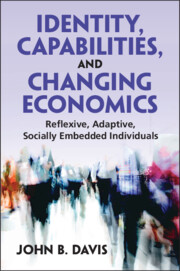Book contents
- Identity, Capabilities, and Changing Economics
- Identity, Capabilities, and Changing Economics
- Copyright page
- Dedication
- Contents
- Tables
- Boxes
- Preface
- Acknowledgments
- Part I The Failed Pathway and Exit Strategies
- 1 Objectivity in Economics and the Problem of the Individual
- 2 The Untenability of the Unembedded Homo economicus
- 3 From the “Reconciliation Problem” to an Individuality Reconstruction Problem
- Part II Building a Socially Embedded Individual Conception
- Part III Value and Subjectivity
- References
- Index
2 - The Untenability of the Unembedded Homo economicus
from Part I - The Failed Pathway and Exit Strategies
Published online by Cambridge University Press: 11 January 2024
- Identity, Capabilities, and Changing Economics
- Identity, Capabilities, and Changing Economics
- Copyright page
- Dedication
- Contents
- Tables
- Boxes
- Preface
- Acknowledgments
- Part I The Failed Pathway and Exit Strategies
- 1 Objectivity in Economics and the Problem of the Individual
- 2 The Untenability of the Unembedded Homo economicus
- 3 From the “Reconciliation Problem” to an Individuality Reconstruction Problem
- Part II Building a Socially Embedded Individual Conception
- Part III Value and Subjectivity
- References
- Index
Summary
Chapter 2 introduces identity analysis and uses it to examine whether the Homo economicus conception can identify real-world individuals. It describes the self-referential, circular character of that conception, and shows that the belief that Homo economicus identifies real-world individuals rests on a fallacious inference known as affirming the consequent. The chapter reviews how the identity concept came into economics by making a person’s individual identity their utility function. This is compared with how social identity theory understands individual identity, and economics and social identity’s view of representative agents is then distinguished. Sen’s multiple selves view of individual identity is contrasted with both in light of its ontological basis. Section 4 of the chapter critically evaluates rationality theory’s two independence axioms regarding preferences, the logical basis for saying choice is context-independent and for the unembedded Homo economicus individual conception. It argues neither can be defended and that not only must choice be seen to be context-dependent, but that individuals need to be seen as socially and historically embedded.
Keywords
- Type
- Chapter
- Information
- Identity, Capabilities, and Changing EconomicsReflexive, Adaptive, Socially Embedded Individuals, pp. 27 - 52Publisher: Cambridge University PressPrint publication year: 2024



